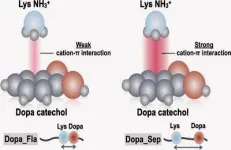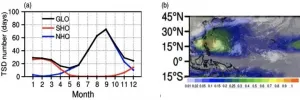(Press-News.org) The genetic material of most organisms is carried by DNA, a complex organic molecule. DNA is very long -- for humans, the molecule is estimated to be about 2 m in length. In cells, DNA occurs in a densely packed form, with strands of the molecule coiled up in a complicated but efficient space-filling way. A key role in DNA's compactification is played by histones, structural-support proteins around which a part of a DNA molecule can wrap. The DNA-histone wrapping process is reversible -- the two molecules can unwrap and rewrap -- but little is known about the mechanisms at play. Now, by applying high-speed atomic-force microscopy (HS-AFM), Richard Wong and colleagues from Kanazawa University (NanoLSI WPI) provide valuable insights into the spatiotemporal dynamics of DNA-histone interactions.
The researchers looked at the interaction between DNA and a histone called H2A, one of the five main histones. To check the applicability of HS-AFM as a viable tool for imaging the DNA-histone interaction, they first focused on H2A in its native state. Wong and colleagues were able to image the topology of the molecule, and how it changes over time. Importantly, they showed that the HS-AFM process, during which a tapping force is constantly exerted on the molecule, does not lead to conformational changes or actual damage.
For real-time observation of the DNA-H2A interaction with HS-AFM, the scientists prepared DNA samples with different lengths and forms: plasmid (long and circular), long-linearized and short-linearized DNA, with the latter having the highest motility. The experiments showed that the choice of substrate on which to put the DNA for AFM imaging is crucial; a particular type of lipid layer was found to be good as it does not strongly absorb DNA strands.
The observations of the interaction of H2A with short-linearized DNA, which the researchers nicknamed 'inchworm DNA', led to the most notable results. Specifically, four different interaction situations could be distinguished: touching, sliding, sandwiching and wrapping, with the associated motions indeed resembling the movements of inchworms.
Wong and colleagues also investigated the effect of ionic strength on the DNA-histone binding affinity, by changing the salt concentration of the liquid containing the DNA-histone aggregate. When increasing the liquid's salinity, the aggregate was found to dissolve. When diluting the liquid again -- and so reducing the salt content -- the aggregate reformed. This result shows that varying the ionic strength (i.e., the salt concentration) of the environment of the DNA-H2A complex provides a way to mimic the variations in the strength of DNA-histone interactions as they happen in living organisms.
The report of Wong and colleagues represents the first real-time observation of DNA-histone interactions, and convincingly shows the applicability of HS-AFM for studying this kind of biological process, also in the context of diseases. Quoting the researchers: "[Our work] demonstrates ... the potential to study protein aggregation and protein-nucleic acid aggregate formation in various human diseases."
Finally, it is worth highlighting the contribution of the paper's first author, Goro Nishide, who is a pre-doctoral student at the Division of Nano Life Science in the Graduate School of Frontier Science Initiative at Kanazawa University. Mr Nishide played a key role in the reported research, supervised by Professor Wong and Dr. Lim, by performing the experiments, co-designing the study and co-writing the paper. Mr Nishide is also enrolled in Kanazawa University's WISE program for Nano-Precision Medicine, Science and Technology, an initiative aimed at innovations in disease prevention, diagnosis, and treatment methods based on exploiting our increased understanding of biological and other processes at the nanoscale.
[Background]
Atomic force microscopy
Atomic force microscopy (AFM) is an imaging technique in which the image is formed by scanning a surface with a very small tip. Horizontal scanning motion of the tip is controlled by piezoelectric elements, while vertical motion is converted into a height profile, resulting in a height distribution of the sample's surface. As the technique does not involve lenses, its resolution is not restricted by the so-called diffraction limit as in X-ray diffraction, for example. In a high-speed setup (HS-AFM), the method can be used to produce movies of a sample's structural evolution in real time, as a typical biomolecule can be scanned in 100 ms or less. Now, Richard Wong and colleagues from Kanazawa University have successfully applied the HS-AFM technique to study the wrapping of DNA around structural proteins.
Division of Nano Life Science in the GRAFINITI and WISE program at Kanazawa University
Goro Nishide, the first author of the paper reporting the application of HS-AFM for visualizing DNA-histone dynamics, is a pre-doctoral student at the Division of Nano Life Science in the Graduate School of Frontier Science Initiative (GRAFINITI), an educational program at Kanazawa University fostering excellent graduate students wishing to participate in establishing the new scientific field of "Nano Probe Life Science". The students' supervisors for this program are all world-class researchers affiliated to the WPI-Nano Life Science Institute (WPI-NanoLSI), a research center established in 2017 as part of Japan's World Premier International Research Center Initiative (WPI) of the Ministry of Education, Culture, Sports, Science and Technology, the objective of which is the creation of world-tier research centers.
In addition, Mr Nishide is enrolled in Kanazawa University's WISE Program for Nano-Precision Medicine, Science, and Technology. Notably, WISE is a five-year integrated pre- and post-doctoral degree program that focuses on five types of diseases in humans (cancer, lifestyle diseases, neurological diseases, diseases caused by small particulates, and diseases caused by nanomaterials). Its mission is to foster technically skilled medical and engineering professionals who all contribute to the creation of innovative disease prevention, diagnosis, and treatment methods through understanding and control on the nanoscale level. The WISE program is nurtured by a community of scientists from four domains (nanometrology, life sciences, supramolecular chemistry, and computational science), all engaging in transdisciplinary dialogue.
INFORMATION:
By ensuring ethnic diversity in a largescale genetic study, an international team of researchers, including a University of Massachusetts Amherst genetic epidemiologist, has identified more regions of the genome linked to type 2 diabetes-related traits.
The findings, published May 31 in Nature Genetics, broaden the understanding of the biological basis of type 2 diabetes and demonstrate that expanding research into different ancestries yields better results. Ultimately the goal is to improve patient care worldwide by identifying genetic targets to treat the chronic metabolic disorder. Type 2 diabetes affects and sometimes debilitates more than 460 million adults worldwide, according to the International Diabetes Federation. About 1.5 million deaths were directly ...
The quality of a sewn garment is dependent on the quality of its seams that are the basic structural element. The factors affecting seam quality in garments include sewing thread type and stitch density. Making the right choice of these helps in getting quality seams in garments. However, the choice of suitable sewing threads and stitch densities for particular fabrics can only be determined through testing.
Dr. Patience Danquah Monnie, from the University of Cape Coast, Ghana, with fellow researchers, conducted research aimed to determine sewing thread brand and stitch density suitable for seams for a selected fabric (79% polyester and 21% cotton) for public basic school uniforms in Ghana. For the research, a 2×3 factorial ...
Nitrates are critical for the growth of plants, so plants have evolved sophisticated mechanisms to ensure sufficient nitrate uptake from their environments. In a new study published in Nature Plants, researchers at Nagoya University, Japan, have identified a plant enzyme that is key to activating a nitrate uptake mechanism in response to nitrogen starvation. This finding explains how plants meet their needs in challenging environments, opening doors to improving agriculture in such environments.
When nitrate levels are plentiful in a plant's environment, a plant can achieve adequate nitrate uptake levels by relying ...
Oxygen (O2) is an essential gas not only for us and most other lifeforms, but also for many industrial processes, biomedicine, and environmental monitoring applications. Given the importance of O2 and other gases, many researchers have focused on developing and improving gas-sensing technologies. At the frontier of this evolving field lie modern nanogap gas sensors--devices usually comprised of a sensing material and two conducting electrodes that are separated by a minuscule gap in the order of nanometers (nm), or thousand millionths of a meter. When molecules of specific gases get inside this gap, they electronically interact with the sensing layer and the electrodes, altering measurable ...
The Yakushima sika deer (yakushika: Cervus nippon yakushimae), a subspecies of the Japanese sika deer (Cervus nippon), evolved without natural predators on the island of Yakushima, in Kagoshima Prefecture, Japan. It inhabits the forests on the island which were declared a World Heritage Site in 1993. Within the site, the yakushika has not been hunted in the past 50 years; however, since 2014, their population has been decreasing. This phenomenon is especially curious, as Japanese researchers believed that sika deer populations in Japan would not decrease without human intervention.
A group of three scientists, including Hokkaido ...
Led by the University of Sydney's Charles Perkins Centre, the study looked at medical data from nearly half a million people and found having overweight or obesity considerably amplified the harmful effects of alcohol on liver disease and mortality.
"People in the overweight or obese range who drank were found to be at greater risk of liver diseases compared with participants within a healthy weight range who consumed alcohol at the same level," said senior author and research program director Professor Emmanuel Stamatakis from the Charles Perkins Centre and the Faculty of Medicine and Health.
"Even for people who drank within alcohol guidelines, participants classified as obese were at over 50 percent greater risk of liver disease."
The researchers ...
Mussels survive by sticking to rocks in the fierce waves or tides underwater. Materials mimicking this underwater adhesion are widely used for skin or bone adhesion, for modifying the surface of a scaffold, or even in drug or cell delivery systems. However, these materials have not entirely imitated the capabilities of mussels.
A joint research team from POSTECH and Kangwon National University (KNU) - led by Professor Hyung Joon Cha and Ph.D. candidate Mincheol Shin of the Department of Chemical Engineering at POSTECH with Professor Young Mee Jeong and Dr. Yeonju Park of the Department ...
Nearly two billion people live in a region where tropical cyclones (TC) are an annual threat. TCs are deadly and can cause billions of dollars in economic losses worldwide. During peak season in the Northern Hemisphere, typically July through October, about two TCs develop or are ongoing every day. However, this and overall TC frequency vary substantially year-to-year.
To quantify this variability, scientists developed a metric called the tropical storm day (TSD). TSD is a collective measure of how frequently tropical cyclones develop, storm track, and cyclone lifespan, which reflects overall activity. Despite this advancement, researchers have not often studied tropical cyclone variability on a global scale.
Now, ...
In a paper published in NANO, researchers from Guizhou Meiling Power Sources Co., Ltd., China have reviewed the recent progress in biopolymer-based electrolyte. The biopolymer materials with unique characteristics including water solubility, film-forming capability and adhesive property played a key role in the design of zero pollution lithium battery. The biopolymers mentioned in this review were polysaccharide, protein, natural rubber and other polymers.
For polysaccharide, cellulose with good wettability, low cost and good mechanical properties can enhance the mechanical strength of membranes and improve interfacial stability between electrolyte and electrode. However, the porosity control of cellulose-based membranes was ...
Habitat change, for example through urbanisation, is one of the most important causes of biodiversity decline. By 2050, settlements and cities across the globe are predicted to increase by two to three million square kilometres - about half the size of Greenland. Natural and semi-natural habitats will thus gradually be replaced by urban habitats.
How wildlife can adapt to such fundamental changes has mostly been studied for a few species groups, such as mammals and birds.
"In order to make predictions about the development of biodiversity as a whole and to combat current phenomena such as insect declines, robust knowledge is also needed for other species groups," ...






